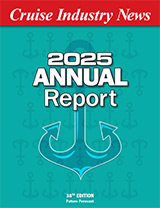At first, Linken D’Souza may seem like an odd hire to run food and beverage for Royal Caribbean International’s 25 ships and estimated 250 dining venues. He’d never worked in the cruise industry, never been on a cruise, and by his own admission had maybe never even seen a cruise ship before taking the job. But spend a little time chatting with him, climb into his background a little bit, and it soon becomes clear D’Souza has almost every other trait normally associated with a cruise industry executive.
For starters, he couldn’t be more international. Born in Dubai to Indian parents of Portuguese decent, he spent most of his life in the Middle East, and then attended university in Switzerland. His first food service job was at the super up-market Restaurant Le Jardin at the Hôtel Le Richemond in Geneva. With a hospitality degree in hand he landed in Canada and took over management of a Red Lobster. His clients were no longer celebrities and royalty but casual diners looking for a great product at a reasonable price. His success multiplied and soon he was managing 90 Red Lobsters across Canada and around the Great Lakes. Managing the vast operation taught skills vital in his current position.
Last summer he accepted an offer to become vice president of food and beverage for the Miami-based cruise line. While his restaurants are now varied, operating 24/7 globally on floating cities, it still comes down to creating that experience for the customer.
“Every step of the way helped me learn what it takes to make a restaurant successful and provide a great experience in really high volume environments,” D’Souza said. “Casual dining used to be for everybody all the time. Today I think it becomes more of a destination. Red Lobster, for the consumer that it served. It was a destination because it is more pricy than the average casual dining restaurant. So, it is a kind of a celebration environment and a lot of the guests were there with something to celebrate – very similar to the cruise lines where a lot of our guests onboard are either celebrating something or enjoying a vacation. So it’s creating those experiences whether it’s a Monday night dinner for the family or a vacation that you’ve saved up for over a couple of years. It’s creating a wow experience for all the guests.”
D’Souza started with Royal Caribbean at the end of August 2017 – a time of major planning for the Symphony of the Seas.
Aside from being at sea, the big difference between running 90 seafood restaurants to managing food and beverage aboard ships is the diversity of product. And each ship is constantly evolving.
“That’s actually one of the most exciting parts of this role that I’ve stepped into, this ability to go from a steakhouse to sushi to fine dining and Wonderland, to Jamie Oliver’s Italian restaurant or one of our pubs. Or all of this huge spread of dining environments and to create all these experiences – almost a city of dining environments – is probably one of the coolest things I’ve ever had the privilege of being able to do,” he said. “In my mind, I had naively thought it will be a restaurant on a ship, how different could it be? And it’s pretty different! The team I’ve had both shoreside and shipboard has helped me mitigate a lot of those learning curves.”
Food operations on land and sea all boil down to a pleasurable experience at a commensurate price – be it on the banks of Lake Geneva or off shore in Glacier Bay.
“Any successful food service program in any part of the hospitality industry boils down to a few simple principles. Number one is deliciously prepared food that’s fresh, executed consistently across the system – whether it’s a cruise ship or a hotel or a freestanding restaurant. Number two, a comfortable, inviting environment that allows you to relax and feel like you are on vacation. Number three, hospitable staff that are genuinely friendly and care about the experience. And lastly, you want a nice cold beverage or a nice glass of wine.”
There is a profound difference, however.
“I think the biggest difference is that they are very different businesses. The cruise vacation, because of the inclusiveness of food, the dollars we spend on food is really a crucial investment toward the guest experience – compared to land-based restaurants it becomes a key control measure from a cost standpoint.
“It’s a little harder to innovate over there because you have very tight restrictions for how much you can spend on a plate, per se, without really taking the price outside the environment of what the customer is accustomed to paying in that restaurant. However, on cruises, the cool thing about it is we get to look at the experience first, design what’s going to wow the guest, and then figure out how we’re going to fund it and allocate the funds after that. So, a slightly different approach in that we look at the wow first and then cost, versus look at the food cost and then decide whether or not we can put it on the menu.”
Excerpt from Cruise Industry News Quarterly Magazine: Spring 2018




